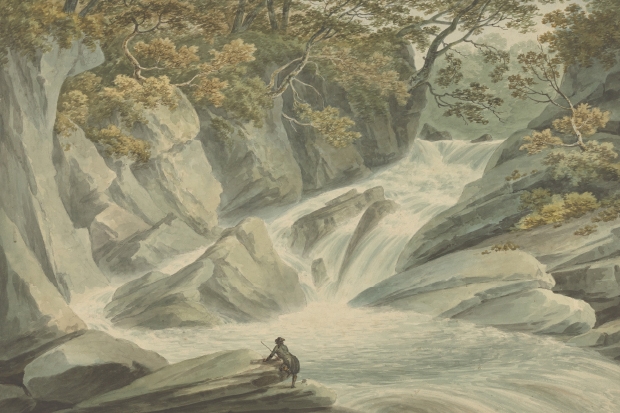Landskipping is about viewing the view, from the 18th century to the present. From the title (which is the only self-conscious thing about this terrific book) I feared we might be in for a heavy dose of Wordworthishness and ‘the lone enraptured male’ school of writing. But Anna Pavord, along with Kathleen Jamie, Dorothy Wordsworth and Jane Austen, is more down-to-earth than any Romantic moper. Like the author of Sense and Sensibility, she sees both sides of the coin.
Romantic mopers, however, do crowd the early pages. Once a ‘correct’ taste for landscape became a desirable attainment in the mid-18th century, the way you looked at wild places was a way of demonstrating sensibility rather than sense. The practical agricultural reformers only began to assert their influence towards the end of the century; and Pavord, with her Welsh farming background and wide-ranging cultural interests, proves a marvellous observer of both ways of looking at what was once known as the country but now gets called the countryside.
The first part of the book deals with how poets and painters reacted to the awesome sights of mountains and lakes. Wordsworth, who could claim that the sounding cataract haunted him like a passion, was less keen on sharing his rapture with tourists. He preferred to keep the Lake District for himself and those who worked the land. (I have always admired Wordsworth for suggesting that ordinary people were transformed into poets when they reacted to landscape. He called them ‘silent poets’ and explained that ‘Michael’ was written to ‘show that men who did not wear fine clothes can feel deeply’.)
Painters could be as susceptible as poets and Wordsworth’s labourers. Constable wrote that ‘painting is but another word for feeling’. But Sawrey Gilpin thought that nature is ‘seldom so correct in composition as to produce a harmonious whole’, and advised draping rocks with shrubs and hanging herbage to make them more picturesque. Thomas Gray, both painter and poet, could only look at Lake Windermere in a Claude glass, a mirror named after Claude Lorraine and used by artists to frame and reflect the view. Before it could be appreciated, Pavord writes, the landscape often had to be mediated — in much the same way as tourists today rely on photographing a place rather than just using their eyes.
The detail is fascinating. We witness John Varley watching clouds, Keats describing a waterfall and then Pavord’s own memory of a waterfall. ‘White noise. Black peaks. Purple prose.’ She tends to self-deprecation, but she shouldn’t, because some of her word-paintings of landscape are beautiful as well as genuine. Rock pools are made from ‘a strange alliance of calm and chaos’; and on a summer evening, she writes of ‘a cacophony of rooks, not going anywhere, shaping and reshaping into fluid dark pools and streams against the sunset’. Observation, without an ounce of ego, is one of the things that make this book so good.

Part One ends with the Member of Parliament and social benefactor Thomas Johnes (1748–1816) and his ‘Heavenly Hafod’ estate near Aberystwyth, which he tried to make as productive as it was picturesque. It never earned money, but the agricultural improvers who overlapped with the aesthetes did shift the emphasis from being possessed by the land to taking possession of it. At the turn of the century, the Yorkshireman William Marshall was writing The Rural Economy of the Southern Counties at the same time as Wordsworth was composing ‘Tintern Abbey’; while William Cobbett and Samuel Palmer coincided in the mid-1820s — and held very different perspectives on fields and woods.
Farmers, we realise, are the real shapers of the landscape we see today. Cobbett, the great social reformer, has a chapter to himself and emerges as the hero of the book. But any missionary message is delicately delivered. There are a few harsh words for those who try to wrestle the land from ‘the grasp of wicked agriculturalists’ and who imagine that the country would then be all picnics and cowslips. Nor does Pavord have much time for the heritage signage that has claimed the patch of Dorset she knows and loves as ‘The Jurassic Coast. Home of Dinosaurs’.
There is much to absorb from this gentle but forceful line of argument. Perhaps the most valuable lesson I was left with was how to look properly at my own patch. Pavord is at her most personal when describing Wales, where she grew up, and West Dorset, where, like the sheep, she feels ‘hefted to the hills’. But her writing is generous, and she wants the reader to share her balanced view. ‘I try not to romanticise this landscape I look at almost every day’, she says. Trying not to romanticise, being more aware of what we see, seems a sensible as well as sensitive way of viewing the view.






Comments